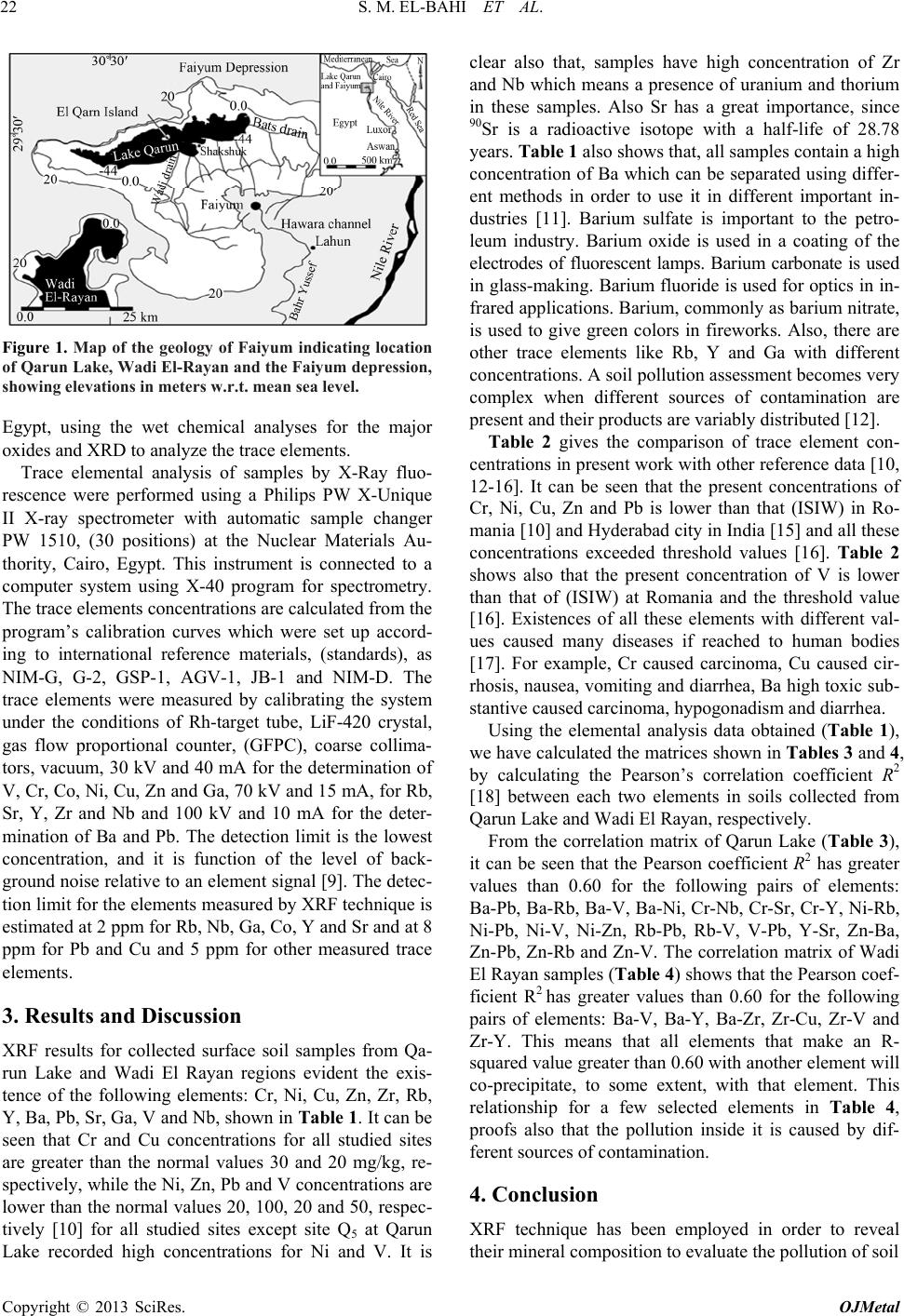
S. M. EL-BAHI ET AL.
22
Figure 1. Map of the geology of Faiyum indicating location
of Qarun Lake, Wadi El-Rayan and the Faiy um depression,
showing elevations in meters w.r.t. mean sea level.
Egypt, using the wet chemical analyses for the major
oxides and XRD to analyze the trace elements.
Trace elemental analysis of samples by X-Ray fluo-
rescence were performed using a Philips PW X-Unique
II X-ray spectrometer with automatic sample changer
PW 1510, (30 positions) at the Nuclear Materials Au-
thority, Cairo, Egypt. This instrument is connected to a
computer system using X-40 program for spectrometry.
The trace elements concentrations are calculated from the
program’s calibration curves which were set up accord-
ing to international reference materials, (standards), as
NIM-G, G-2, GSP-1, AGV-1, JB-1 and NIM-D. The
trace elements were measured by calibrating the system
under the conditions of Rh-target tube, LiF-420 crystal,
gas flow proportional counter, (GFPC), coarse collima-
tors, vacuum, 30 kV and 40 mA for the determination of
V, Cr, Co, Ni, Cu, Zn and Ga, 70 kV and 15 mA, for Rb,
Sr, Y, Zr and Nb and 100 kV and 10 mA for the deter-
mination of Ba and Pb. The detection limit is the lowest
concentration, and it is function of the level of back-
ground noise relative to an element signal [9]. The detec-
tion limit for the elements measured by XRF technique is
estimated at 2 ppm for Rb, Nb, Ga, Co, Y and Sr and at 8
ppm for Pb and Cu and 5 ppm for other measured trace
elements.
3. Results and Discussion
XRF results for collected surface soil samples from Qa-
run Lake and Wadi El Rayan regions evident the exis-
tence of the following elements: Cr, Ni, Cu, Zn, Zr, Rb,
Y, Ba, Pb, Sr, Ga, V and Nb , shown in Tab le 1 . It can be
seen that Cr and Cu concentrations for all studied sites
are greater than the normal values 30 and 20 mg/kg, re-
spectively, while the Ni, Zn, Pb and V concentrations are
lower than the normal values 20, 100, 20 and 50, respec-
tively [10] for all studied sites except site Q5 at Qarun
Lake recorded high concentrations for Ni and V. It is
clear also that, samples have high concentration of Zr
and Nb which means a presence of uranium and thorium
in these samples. Also Sr has a great importance, since
90Sr is a radioactive isotope with a half-life of 28.78
years. Table 1 also shows that, all samples contain a high
concentration of Ba which can be separated using differ-
ent methods in order to use it in different important in-
dustries [11]. Barium sulfate is important to the petro-
leum industry. Barium oxide is used in a coating of the
electrodes of fluorescent lamps. Barium carbonate is used
in glass-making. Barium fluoride is used for optics in in-
frared applications. Barium, commonly as barium nitrate,
is used to give green colors in fireworks. Also, there are
other trace elements like Rb, Y and Ga with different
concentrations. A soil pollu tion assessment becomes very
complex when different sources of contamination are
present and their products are variably distributed [12].
Table 2 gives the comparison of trace element con-
centrations in present work with other reference data [10,
12-16]. It can be seen that the present concentrations of
Cr, Ni, Cu, Zn and Pb is lower than that (ISIW) in Ro-
mania [10] and Hyderabad city in India [15] and all these
concentrations exceeded threshold values [16]. Table 2
shows also that the present concentration of V is lower
than that of (ISIW) at Romania and the threshold value
[16]. Existences of all these elements with different val-
ues caused many diseases if reached to human bodies
[17]. For example, Cr caused carcinoma, Cu caused cir-
rhosis, nausea, vomiting and diarrhea, Ba high toxic sub-
stantive caused carcinoma, hypogonadism and diarrhea.
Using the elemental analysis data obtained (Table 1),
we have calculated the matrices shown in Table s 3 and 4,
by calculating the Pearson’s correlation coefficient R2
[18] between each two elements in soils collected from
Qarun Lake and Wadi El Rayan, respectively.
From the correlation matrix of Qarun Lake (Table 3),
it can be seen that the Pearson coefficient R2 has greater
values than 0.60 for the following pairs of elements:
Ba-Pb, Ba-Rb, Ba-V, Ba-Ni, Cr-Nb, Cr-Sr, Cr-Y, Ni-Rb,
Ni-Pb, Ni-V, Ni-Zn, Rb-Pb, Rb-V, V-Pb, Y-Sr, Zn-Ba,
Zn-Pb, Zn-Rb and Zn-V. The correlation matrix of Wadi
El Rayan samples (Table 4) shows that the Pearson coef-
ficient R2 has greater values than 0.60 for the following
pairs of elements: Ba-V, Ba-Y, Ba-Zr, Zr-Cu, Zr-V and
Zr-Y. This means that all elements that make an R-
squared value greater than 0.60 with another element will
co-precipitate, to some extent, with that element. This
relationship for a few selected elements in Table 4,
proofs also that the pollution inside it is caused by dif-
ferent sources of contamination.
4. Conclusion
XRF technique has been employed in order to reveal
their mineral composition to evaluate the pollution of soil
Copyright © 2013 SciRes. OJMetal